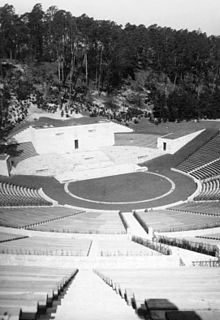Waldbühne
 Aerial view (2019) | |
 | |
| Former names | Dietrich-Eckart-Freilichtbühne (1936–48) |
|---|---|
| Address | Glockenturmstraße 1 14053 Berlin Germany |
| Location | Olympiapark Berlin |
| Coordinates | 52°30′57″N 13°13′44″E / 52.51583°N 13.22889°E |
| Owner | Senate of Berlin |
| Operator | CTS Eventim |
| Type | Amphitheatre |
| Capacity | 22,290 |
| Construction | |
| Built | 1934–36 |
| Opened | 2 August 1936 |
| Renovated | 1969, 1982 |
| Website | |
| Venue website (in German) | |
The Waldbühne (Woodland Stage or Forest Stage) is a theatre at Olympiapark Berlin in Berlin, Germany. It was designed by German architect Werner March in emulation of a Greek theatre and built between 1934 and 1936 as the Dietrich-Eckart-Freilichtbühne (Dietrich Eckart Open Air Theater), a Nazi Thingplatz, and opened in association with the 1936 Summer Olympics. Since World War II it has been used for a variety of events, including boxing matches, film showings and classical and rock concerts. It seats more than 22,000 people. The venue is located off Friedrich-Friesen-Allee just northeast of Glockenturmstraße.
Nazi era

The theatre was built as part of the Olympic complex on the request of Propaganda Minister
The theatre opened on 2 August 1936, the day after the opening of the games, with the première of
Post-war

After World War II, the Olympic grounds were within the British occupation sector of Berlin. They were released for public use beginning in 1948,
Jimi Hendrix second-to-last appearance in "Berlin Super Concert70" was planned at the Waldbühne on 4 September 1970. Due to bad weather conditions, it was relocated to the Deutschlandhalle. Alongside were also Ten Years After and Procol Harum. In the reality series Pawn Stars, Rick Harrison bought a rare poster for this concert for $4,000 (episode #20 of season 5, aired 30 January 2012).[citation needed]
Following a concert by
.The Berlin Philharmonic holds its outdoor concert there every summer, featuring noted guest artists. This concert has been broadcast on live TV since 1992.
The facility seats more than 22,000,[21] in three ranks that rise 30 metres (98 ft);[13] the last row of seats, the 88th, is also 93.5 metres (307 ft) from the centre of the orchestra pit, so originally 40 microphones were installed on-stage, feeding 10 coordinated groups of loudspeakers.[3] In 1982, a canopy costing 200,000 € was erected over the stage, providing both a visual and an acoustic barrier.[13] Concert promoter Peter Schwenkow leased it from 1981 until the end of 2008, when the lease was transferred to CTS Eventim.[13][22]
Before
See also
- List of contemporary amphitheaters
References
- ISBN 978-3-7643-2455-1, p. 60(in German)
- ^ (in German)
- ^ a b Glen Gadberry, "The Thingspiel and Das Frankenberger Wurfelspiel", The Drama Review 24.1, March 1980, pp. 103–14, p. 106.
- ISBN 978-3-934285-46-0, p. 260(in German)
- ISBN 978-3-87038-095-3, p. 212(in German)
- ISBN 978-3-422-03111-1, p. 229(in German)
- OCLC 490115936(in German), pp. 56, 58, 59. Photograph of the arena, p. 57.
- ^ ISBN 978-3-922561-31-6, p. 207 (in German)
- ISBN 978-3-7728-0667-4, pp. 235–48 [235–36].
- ISBN 978-1-57113-252-9, p. 157.
- ^ a b c "Berliner Waldbühne", TV Berlin, 30 May 2011 (in German)
- ISBN 978-1-58567-345-2, p. 238.
- ^ a b c d e f g h Waldbühne Archived 2015-10-30 at the Wayback Machine, Sehenswürdigkeiten, Berlin.de (in German)
- ^ a b "Die Waldbühne: Amphitheater der Stars", Der Tagesspiegel, 26 March 2011 (in German)
- ISBN 978-3-8353-0073-6, p. 251(in German)
- ISBN 978-1-59845-209-9, n.p.
- ISBN 978-3-531-93457-0, p. 260 (in German) assess the property damage at almost half a million DM, but include damage to S-Bahncarriages.
- Movement 2 Juneanarchist group, was one of numerous fans who pushed their way in without paying and in some cases came looking for trouble.
- ^ H. Bruns, "Poker um die Waldbühne. Wer betreibt die schönste Konzert-Location Europas? Kandidaten zögern wegen der hohen Miete", Bild, 28 July 2008 (in German)
- ^ "1965: Rolling Stones in der Berliner Waldbühne", 60 Jahre der Bundesrepublik Deutschland, Bild, 14 April 2009 (in German), assessing the damages at 300,000 €.
- ^ According to Bild, "Poker um die Waldbühne", 22,120.
- ^ "Veranstalter: CTS Eventim übernimmt Berliner Waldbühne", Der Tagesspiegel, 9 September 2008 (in German)
- ^ "Tour | System of a Down". 21 May 2017.
- ^ "In Concert | CelineDion.com". www.celinedion.com. Retrieved 13 April 2022.
External links
- Geoff Walden, Dietrich-Eckart-Bühne, Third Reich in Ruins: then and now photographs
- Gunnar Schupelius, "The Secret Behind the Stage. Berlin's Enchanting Waldbühne Amphitheater", The Atlantic Times, May 2006.
- Pascale Hugues, tr. Elisabeth Thielicke, "Mon Berlin: Umhüllt vom Wald, bebend wie eine frisch Verliebte", Meinung, Der Tagesspiegel, 26 August 2011 (in German)

